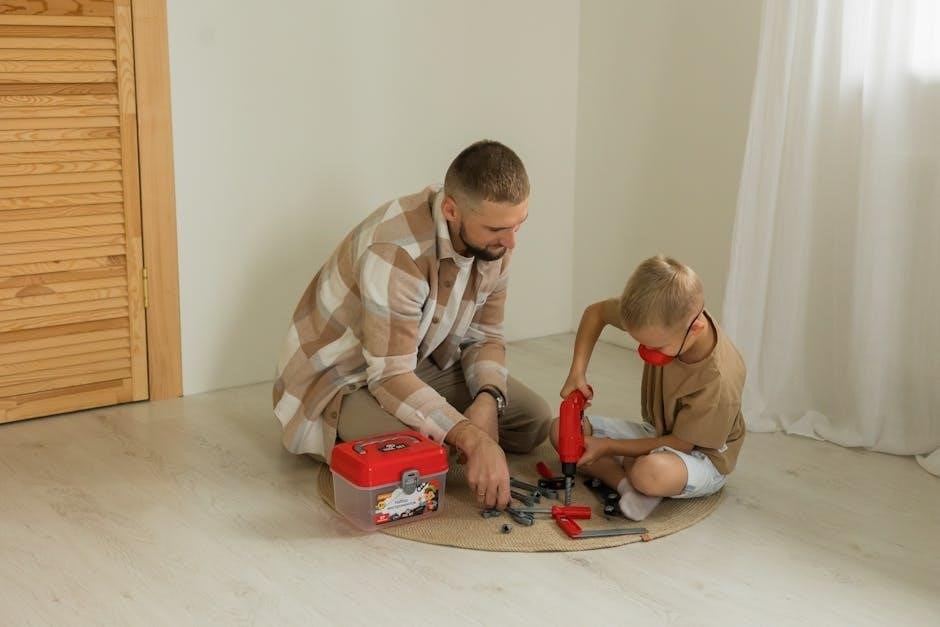winch guide
A winch is a mechanical device designed to pull objects efficiently, often used in emergencies or off-road recovery․ Its power depends on the vehicle’s electrical system, emphasizing efficient energy use․ The winch operates best when pulling from the first rope layer on the drum, highlighting the importance of proper setup and safe practices․ Understanding winch basics, safety guidelines, and maintenance is crucial for effective and secure operation in various scenarios․
What is a Winch?
A winch is a mechanical device designed to pull or lift heavy loads efficiently․ It typically consists of a drum or cylinder around which a rope, cable, or chain is wound․ Winches are commonly used in vehicles, boats, and industrial settings for recovery, lifting, or securing objects․ They can be powered by electricity, hydraulics, or manual effort, depending on the type․ The primary function of a winch is to provide controlled tension and pulling force, making it an essential tool for emergencies, construction, and off-road adventures․
Why Do You Need a Winch?
A winch is essential for off-road recovery, emergencies, and heavy-duty tasks․ It provides the necessary pulling power to rescue vehicles stuck in challenging terrain or to lift and move heavy objects safely․ Whether for 4×4 adventures, marine applications, or industrial use, a winch ensures you can handle situations where manual effort is insufficient․ Its ability to apply consistent tension and control makes it a critical tool for securing loads and preventing accidents․ Investing in a winch enhances your preparedness and safety in various scenarios, making it a versatile and indispensable asset․
Basic Components of a Winch
A winch typically consists of a drum for storing the cable or rope, a motor or gear system for providing pulling power, and a control mechanism for operation․ The rope or cable is wrapped around the drum, and its length varies depending on the model․ The gear system ensures efficient power transmission, while the brake system maintains control during operation․ Some winches also include a remote control for safe and convenient use․ These components work together to enable reliable and efficient pulling or lifting, making winches versatile tools for various applications․

Types of Winches
Winches are categorized based on their power source and mechanism․ Common types include electric, hydraulic, manual, and capstan winches, each suited for specific applications and environments․
Electric Winches
Electric winches are powered by an electric motor, making them ideal for vehicles and boats with access to a battery or power source․ They offer high-speed operation and ease of use, with minimal manual effort required․ These winches are commonly used in off-road recovery, marine applications, and industrial settings․ Their key advantage is consistent pulling power and quick response, but they can be heavy and reliant on a power supply․ Regular maintenance, such as checking the motor and wiring, ensures optimal performance and longevity․
Hydraulic Winches
Hydraulic winches are powered by hydraulic fluid pressure, offering exceptional strength and reliability for heavy-duty applications․ They are commonly used in construction, agriculture, and marine environments where high pulling power is essential․ These winches provide smooth operation and consistent torque, making them ideal for lifting and moving heavy loads․ A key advantage is their ability to function in harsh conditions without overheating․ However, they require a hydraulic power source and can be heavier than electric or manual winches․ Regular fluid checks and maintenance are crucial to ensure optimal performance and longevity․
Manual Winches
Manual winches are non-powered, relying on human effort to operate, making them simple and cost-effective․ They are ideal for lighter applications, such as securing loads on trailers or boats, due to their portability and ease of use․ These winches typically feature a crank or handle for winding and unwinding the rope or cable․ While they require physical labor, manual winches are highly reliable and suitable for scenarios where power sources are unavailable․ They are a practical choice for small-scale tasks and emergencies, offering a straightforward solution without the need for complex setups or maintenance․
Capstan Winches
Capstan winches are versatile tools commonly used in marine and industrial settings․ They feature a rotating drum around which rope or cable is wrapped, allowing for controlled lifting or pulling of heavy loads․ Unlike traditional winches, capstan winches do not have a reel, making them ideal for applications where space is limited․ They are highly durable and can handle both horizontal and vertical lifting tasks․ While they often require manual operation, capstan winches are known for their efficiency and reliability in various industries, including boating and construction․

Key Considerations When Choosing a Winch
Selecting the right winch involves evaluating weight capacity, rope length, power source, durability, and budget․ Assess the required pulling power and material quality to ensure reliability and safety․
Weight Capacity and Pulling Power
The winch’s weight capacity must exceed the load it will handle․ For vehicles, consider the gross vehicle weight rating (GVWR)․ Ensure the winch can manage the maximum expected load․ Pulling power varies between single-line and dual-line operations, with dual-line offering greater force․ Always choose a winch with a higher capacity than your needs to avoid overloading․ Underestimating requirements can lead to damage or safety hazards․ Check the gear ratio and motor efficiency, as they directly impact pulling power and speed․
Rope Length and Material
Choosing the right rope length and material is crucial for efficient winching․ Synthetic ropes, like nylon or polyester, are lightweight, flexible, and resistant to abrasion, making them ideal for most applications․ Steel ropes, while heavier, offer superior strength and durability for heavy-duty tasks․ The rope length should match the intended use, with longer ropes providing greater versatility but adding weight and complexity․ Always select a rope rated for the winch’s capacity to ensure safety and performance․ Proper material selection enhances reliability and extends the winch’s service life․
Power Source and Efficiency
The power source of a winch significantly impacts its performance and efficiency․ Electric winches are popular for their quick operation and ease of use, relying on a vehicle’s battery․ Hydraulic winches, powered by fluid pressure, excel in heavy-duty applications but require a separate power source․ Manual winches, operated by hand, are simple and reliable but slower․ Efficiency varies based on the power source, with electric winches offering fast recovery and hydraulic winches providing consistent strength․ Choosing the right power source ensures optimal performance for specific tasks and conditions, balancing speed, strength, and convenience effectively․
Durability and Build Quality
Durability and build quality are critical factors in ensuring a winch’s longevity and reliability․ High-quality winches are typically constructed with robust materials like steel or aluminum, designed to withstand harsh environments and heavy use․ Look for models with sealed components to protect against dust and water ingress․ A durable winch also features a reliable gearbox and sturdy housing to handle heavy loads without compromise․ Additionally, protective coatings or finishes, such as galvanized or powder-coated surfaces, enhance resistance to corrosion․ A well-built winch ensures consistent performance and minimizes the risk of mechanical failure during critical operations․
Budget and Cost-Effectiveness
Budget and cost-effectiveness are crucial when selecting a winch, ensuring you find a balance between quality and affordability․ Set a budget based on your specific needs and intended use․ While cheaper options may seem appealing, prioritize durability and performance to avoid frequent replacements․ Consider the long-term savings of investing in a reputable brand with a good warranty․ Regular maintenance can also extend the winch’s lifespan, making it a cost-effective choice over time․ Evaluate features against price to ensure you’re getting value for your money without compromising on essential functionality․

Safety Guidelines for Winch Use
Always prioritize safety by adhering to load capacity limits, inspecting ropes, and wearing proper gear․ Ensure clear communication and a well-planned recovery strategy to minimize risks․
Safe Operating Practices
Always wear protective gear, including gloves and safety glasses, to prevent injury from flying debris․ Ensure the winch is properly secured to a stable anchor point, and never exceed its weight capacity․ Conduct regular inspections of cables, hooks, and winch components for wear or damage․ Maintain clear communication with team members during operations, and ensure bystanders are at a safe distance․ Avoid sudden jerks or overloading, as this can cause equipment failure or accidents․ Always follow the manufacturer’s guidelines for operation and load management․
Emergency Precautions
In case of winch failure or overload, immediately shut off the power source and avoid standing in the path of the wire rope․ Never attempt to stop or catch a snapping cable, as it can cause severe injury․ Keep emergency tools nearby, such as a knife or cutting tool, to release tension if needed․ Always have a backup plan and ensure everyone involved knows the steps to take in an emergency․ Regularly inspect the winch and cables for signs of wear to prevent sudden failures․ Stay calm and follow a structured approach to mitigate risks effectively․
Winch Maintenance Tips
Regular lubrication of moving parts ensures smooth operation and prevents corrosion․ Inspect wire ropes for frays, kinks, or damage; replace them if compromised․ Clean the winch frequently to remove dirt and debris that could affect performance․ Check the brake system for proper function to maintain control during use․ Store the winch in a dry, protected area when not in use to prevent rust․ Schedule professional servicing if you notice any unusual noises or decreased efficiency; Proper maintenance extends the lifespan and reliability of your winch․

Winching Techniques
Winching techniques involve strategic pulling methods, such as straight-line or angled pulls, using proper equipment and safety measures to ensure effective and secure operations in various scenarios․
Basic Winching Techniques
Basic winching techniques are essential for safe and effective operations․ Always assess the load and anchor point before starting․ Use a straight-line pull when possible to avoid side loading․ Secure the rope properly and maintain tension to prevent slack․ Never exceed the winch’s capacity․ Ensure the area is clear of bystanders and use gloves to protect hands․ Apply steady, controlled pulls, avoiding sudden jerks․ If needed, use snatch blocks or pulleys to change direction or increase mechanical advantage․ Always maintain control and monitor the winching process closely․
Advanced Winching Techniques
Advanced winching techniques involve complex maneuvers for challenging situations; Double-line pulls and pulley systems can redirect forces or increase mechanical advantage․ Use anchor points strategically to distribute load stress effectively․ For uneven terrain, employ side pulls cautiously, ensuring the winch and vehicle can handle the strain․ Monitor tension closely to avoid overloading․ In recovery scenarios, combine winching with other methods like towing or lifting for better control․ Always assess risks and plan steps meticulously to ensure safety and efficiency in high-stakes operations․
Vehicle Recovery Techniques
Vehicle recovery techniques require strategic planning and precision․ Assess the environment, ensuring stable anchor points and clear pathways․ Use snatch blocks or pulleys to redirect force and reduce strain on the winch․ Monitor tension to avoid overloading, and control pulling speed to prevent sudden jerks․ Employ throttle control or specialized equipment for regulated force․ Communicate effectively with hand signals or radios․ Secure winch straps properly to maximize stability․ After recovery, inspect the vehicle and winch for damage․ Consider terrain-specific strategies, like higher pulling power in mud․ Maintain control throughout, gradually increasing tension․ Post-recovery checks ensure equipment readiness․

Applications of Winches
Winches are essential tools in various industries, including off-road recovery, marine, construction, and search and rescue operations․ Their versatility makes them indispensable for lifting, pulling, and securing loads․
Off-Road and 4×4 Recovery
Winches are indispensable for off-road and 4×4 recovery, enabling vehicles to navigate challenging terrains like mud, sand, or rocks․ They are crucial for pulling stuck vehicles to safety, towing immobilized trucks, or maneuvering heavy loads․ Electric or hydraulic winches are commonly mounted on bumpers or frames, providing reliable pulling power․ Proper use requires understanding load limits and employing safety gear like straps and shackles․ Regular maintenance ensures optimal performance in emergencies․ Winches are a lifeline for off-road enthusiasts, facilitating self-recovery or collaborative rescue operations in remote areas․
Marine and Boating Applications
Winches are essential in marine environments for anchoring, lifting, and recovering boats or gear․ They are widely used on sailboats, yachts, and fishing vessels to manage heavy loads like anchors, dinghies, or nets․ Hydraulic or electric winches are preferred for their power and efficiency in saltwater conditions․ Durable materials, such as stainless steel, ensure longevity against corrosion․ Proper installation and regular maintenance are critical to prevent failure during operations․ Winches also play a role in rescue missions, helping to recover stranded vessels or passengers safely and effectively in open waters․
Industrial and Construction Use
Winches are vital in industrial and construction settings for lifting, moving, and securing heavy loads․ They are commonly used in crane systems, scaffolding, and material handling․ Electric or hydraulic winches are preferred for their high torque and reliability in demanding environments․ In construction, they assist in lifting building materials, such as steel beams or concrete, to upper floors․ Durable designs and safety features ensure precise control and minimize risks․ Regular maintenance is crucial to uphold performance and safety standards in these high-stakes applications, where equipment failure could lead to significant delays or accidents․
Search and Rescue Operations
Winches play a critical role in search and rescue missions, enabling the safe retrieval of individuals or objects in challenging environments․ Hydraulic or electric winches are often used for their reliability and precision control․ They are deployed in disaster zones, remote areas, or for water rescues, providing the necessary force to lift or pull people to safety․ Durable and portable designs make them ideal for such operations․ Proper training and regular maintenance ensure winches perform effectively in high-stakes rescue situations, minimizing risks and saving lives․

Installation and Maintenance
Proper installation ensures winch functionality and safety․ Regular maintenance, like lubricating moving parts and inspecting wire ropes, is crucial for optimal performance and longevity․
Where to Install a Winch
The ideal location for installing a winch depends on its intended use and vehicle type․ For off-road vehicles, the front bumper is the most common spot due to its accessibility and direct pulling angle․ Rear installations are less common but can be useful for recovery situations․ Marine winches are typically mounted on boats near the bow or stern․ Industrial winches are often placed on machinery or fixed structures․ Always ensure the mounting surface is sturdy and aligned properly to avoid damage or unsafe operations․
How to Install a Winch
Installing a winch requires careful planning and attention to detail․ Start by assessing your vehicle’s weight and intended use to choose the right winch․ Mount the winch to a sturdy frame or bumper, ensuring it’s level and securely fastened․ Use high-strength bolts and reinforcing plates if necessary․ Connect the wiring to your vehicle’s battery, following the manufacturer’s instructions․ Attach the rope or cable, ensuring it’s properly seated and free from twists․ Test the winch under light load before full operation to ensure smooth function and safety․
Regular Maintenance Checks
Regular maintenance ensures optimal winch performance and longevity․ Inspect the rope or cable for frays, abrasions, or kinks, replacing it if damaged․ Clean the winch thoroughly, especially after exposure to mud or saltwater, to prevent corrosion․ Lubricate moving parts like gears and bearings to reduce friction and wear․ Check electrical connections for tightness and corrosion, ensuring reliable power supply․ Test the winch under load periodically to identify any issues early․ Follow a maintenance schedule, ideally after each use or every 3-6 months, to keep your winch functioning smoothly and safely․

Top Winch Brands and Models
Prominent brands like Warn and SmarWinch lead the market, offering high-quality winches known for durability and performance․ These models are popular for their reliability and innovative features․
Warn Winches
Warn winches are renowned for their exceptional durability and reliability, making them a top choice for off-road enthusiasts and professionals․ Known for their heavy-duty performance, Warn offers a wide range of models, including the M8000 and VR EVO series, which are popular for their high pulling power and advanced features․ These winches are designed to handle tough terrain and heavy loads, featuring robust constructions, sealed motors, and innovative technologies like synthetic rope and wireless remote controls․ Warn’s commitment to quality ensures their winches are trusted for both recreational and industrial applications, delivering unmatched performance in demanding situations․
SmarWinch
SmarWinch is a leading brand offering high-quality electric winches designed for off-road and 4×4 enthusiasts․ Known for their efficiency and reliability, SmarWinch models like the X3 and X5 are popular for their robust performance and user-friendly designs․ These winches feature synthetic ropes, waterproof ratings, and advanced motor technologies, ensuring durability in harsh environments․ SmarWinch focuses on affordability without compromising on power and functionality, making them a favorite among adventurers seeking a blend of strength and portability for vehicle recovery and towing needs․
Other Notable Brands
Besides Warn and SmarWinch, several other brands stand out in the winch market․ Ramsey Winches are renowned for their heavy-duty performance and reliability, often used in industrial and commercial settings․ Superwinch offers a wide range of models, catering to both recreational and professional users․ Viking and Kogan are also notable for their high-quality, durable designs․ These brands provide innovative features, robust build quality, and excellent customer support, making them strong contenders for various winching needs and preferences;

Winch Accessories
Winch accessories, like cables, ropes, hooks, shackles, remote controls, and wiring kits, enhance performance, safety, and functionality․ Choose the right ones based on your winch’s intended use and load capacity․
Winch Cables and Ropes
Winch cables and ropes are essential for ensuring safe and efficient operations․ Steel cables are durable and resistant to abrasion, while synthetic ropes are lighter, easier to handle, and offer better shock absorption․ The choice depends on the application, with steel cables often used for heavy-duty tasks and synthetic ropes preferred for vehicles and marine applications․ Proper sizing, material quality, and regular inspections are crucial to prevent wear and tear․ Always select cables or ropes that match your winch’s capacity and intended use for optimal performance and safety․
Winch Hooks and Shackles
Winch hooks and shackles are critical components for securing loads safely․ Hooks are typically forged from high-strength steel or aluminum alloy, designed to withstand heavy loads without deforming․ Shackles provide a secure attachment point, often with screw-pin or safety mechanisms to ensure reliability․ When selecting hooks and shackles, consider the load capacity, material durability, and environmental conditions․ Always choose options rated for your winch’s capacity and intended use․ Regular inspections for wear or damage are essential to maintain safety and prevent failures during operation․
Remote Controls and Wiring Kits
Remote controls and wiring kits enhance the convenience and safety of winch operation․ Remote controls allow users to operate the winch from a safe distance, reducing the risk of accidents․ Wired remotes are durable and reliable, while wireless options offer greater flexibility․ Wiring kits include essential components like solenoids, connectors, and cables, ensuring proper electrical connections․ When selecting these accessories, prioritize compatibility with your winch model and ensure compliance with safety standards․ Proper installation and regular checks are crucial for reliable performance and longevity․

Troubleshooting Common Issues
Identify common winch issues like motor overheating or cable tangles․ Check for blockages, worn parts, or electrical faults․ Regular maintenance prevents breakdowns and ensures smooth operation․
Identifying and Fixing Problems
Start by inspecting the winch for visible damage or wear․ Check the motor, gearbox, and cable for blockages or tangles․ If the winch doesn’t engage, ensure the battery is charged and connections are secure․ For slow operation, inspect the rope for kinks or debris․ Lubricate moving parts if stiffness is detected․ Replace worn or damaged components immediately to prevent further damage․ Always refer to the user manual for specific troubleshooting steps tailored to your winch model․ Regular maintenance can help identify issues before they escalate․
When to Replace a Winch
Replace a winch if it shows significant wear, such as a frayed or damaged cable, stripped gears, or a seized motor․ If the winch fails to hold a load or operates erratically, it’s time for a replacement․ Corrosion, rust, or structural damage to the drum or frame also necessitates a new winch․ Additionally, if repair costs exceed the price of a new unit or parts are no longer available, replacement is the best option․ Always prioritize safety by replacing a winch that no longer performs reliably․
Winches are versatile tools for recovery, lifting, and towing, offering reliability and efficiency across various applications․ Always use them safely and maintain them for optimal performance․
Winches are essential tools for lifting, towing, and recovery, offering versatility across industries․ Key considerations include weight capacity, rope material, and power source․ Safety practices, regular maintenance, and proper installation are crucial for optimal performance․ Understanding winching techniques enhances efficiency, while adhering to emergency protocols ensures user safety․ With various types like electric, hydraulic, and manual winches, selecting the right one for your needs is vital․ Always follow guidelines and maintain your winch to prolong its lifespan and reliability in critical situations․
Final Tips for Effective Winch Use
Always assess the situation before winching to ensure safety and efficiency․ Use the correct gear ratio and rope type for the job․ Regularly lubricate moving parts to prevent wear․ Inspect cables for damage and replace them if necessary․ Practice proper anchoring techniques to avoid slippage․ Follow manufacturer guidelines to avoid overloading․ Keep bystanders at a safe distance during operation․ Store the winch properly when not in use to maintain its condition․ Finally, stay alert and prepared for emergencies․ These tips ensure safe and effective winch use in any scenario․

